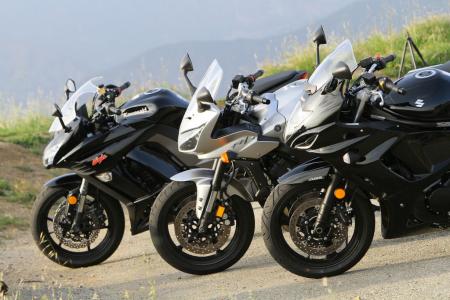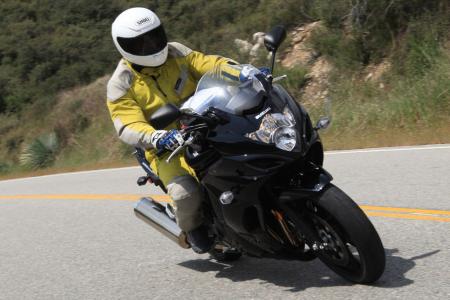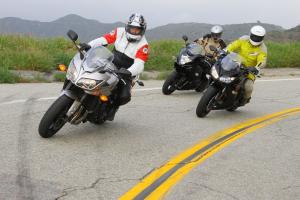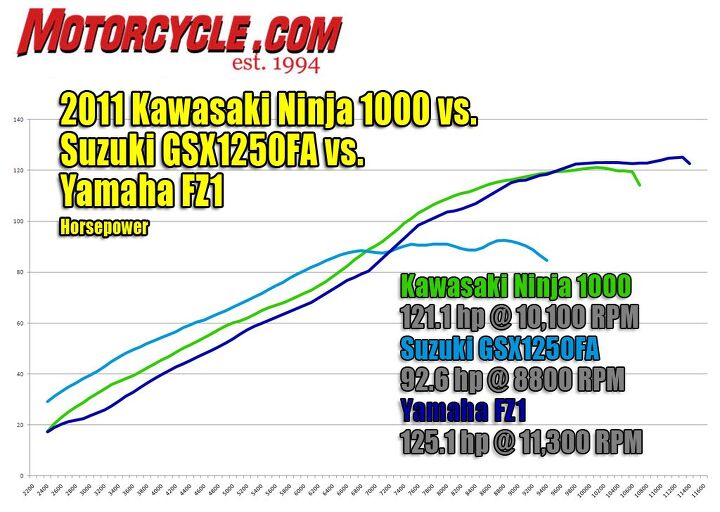Here are three ways to satisfy a thirst for a powerful sportbike without the pretzel-ed legs and sore wrists.
What started as a duel between the 2011Kawasaki Ninja 1000 and 2011 YamahaFZ1 morphed into a Mexican stand-off with the last-minute appearance of the 2011Suzuki GSX1250FA. The Suzuki’s arrival broadened the scope of what a gentlemen’s sportbike can be by counterweighting some of the shortcomings of the other two bikes.
Introduced this year, the Kawasaki Ninja 1000 and Suzuki GSX1250FA are the freshest models in this three-bike comparison. The Suzuki is a refreshed Bandit, now with a full fairing and standard antilock brakes bringing a heavier sport-touring aspect to the class.
 Liter-sized sportbikes without torture-rack ergos can ably shift from commuter to sport-tourer to canyon-carver. |
The Ninja counters with a greater sport focus and a raging four-cylinder engine from the Z1000 but doesn't necessarily assure conquest of the other two. In fact, each of our 40-plus-year-old group of testers presents convincing reasons why either bike could win this shootout, depending on the potential rider. The rebadged Bandit (aka, GSX) and long-in-the-tooth (well, since 2006…) Yamaha FZ1 retain some superior qualities Ninja engineers dismissed, forgot or didn’t realize they should incorporate on their new liter-sized sportbike.
What the Ninja has on its Yamaha competitor is motor — gobs and gobs of mid-range motor. An impromptu six-gear roll-on with Editor Duke on the Kawasaki left me on the Yamaha counting seconds while the FZ1’s inline four-cylinder spun up revs. Once in the meat of the R1-derived engine’s powerband the forward surge was invigorating, but by this time Duke was an off-ramp down the freeway. By itself the FZ1 is plenty fast, but when up against the new Ninja the Yamaha feels downright anemic until spun up.
“A motorcycle’s engine is a key ingredient in riding dynamics, and in this respect, the Ninja’s motor delivers a superior experience,” says Editor Duke. “Its low-end hit easily outmuscles the Yamaha, and its shorter gearing always has the engine in its expansive sweet spot. Any race across an intersection will be won by the Kawi.”
The GSX1250FA, with its 72.3 ft-lb of torque at 3,500 rpm, is a better match for the Ninja’s 71.6 ft-lb at 7,800 rpm. But with a curb weight of 567 lbs., the portly Suzuki is 64 lbs. heavier than the Kawasaki (503 lbs.) and 80 lbs. more than the FZ1 (487 lbs.). With 68 ft-lb or more of torque from an rpm as low as 2,700 rpm to a high of 6,800 rpm the GSX has, in fact, the broadest spread of torque of the three bikes by a big margin. Where the GSX falls short is in the horsepower department, producing a paltry 92.6 hp at 8,800 rpm compared to the Ninja’s 121.1 at 10,100 rpm and the FZ’s 125.1 horses all the way up at 11,300 rpm.
To say that Kawasaki got it right with this engine is an understatement. The new Ninja 1000 has the perfect blend of sportbike performance packaged to be delivered in usable quantities during street riding conditions. According to “Resident Boomer,” Glenn Giardinelli, “The Ninja 1000 pushes the envelope of what a gentleman's sportbike can be. Kawasaki made a potent motor for everyday street use. This bike has more low- and mid-range torque than any stock sportbike I've ridden.”
Considering the Suzuki’s displacement of 1255cc (79.0 mm x 64.0 mm bore and stroke), not producing a triple-digit horsepower figure is somewhat disappointing but is generally masked by its phenomenal torque output – it cranks out low-rev power like a V-Twin.
The Ninja and the FZ1 share an identical 77.0mm bore, but the Kawi’s engine carries more displacement than the FZ1 (1043cc vs. 998cc) by virtue of a marginally longer stroke (56.0mm vs. 53.6mm), and it also possesses a slightly greater compression ratio (11.8:1 vs. 11.5:1). These combine with distinct camshaft profiles to deliver quite different power characteristics. If you have a thing for the top-end pop synonymous with track-oriented sportbikes, you may prefer the FZ1. But where it matters in real-world riding scenarios, we preferred the Ninja or the GSX.
With seating position, reach to handlebars and the distance from seat to footpeg hardly discernible between them, all three bikes earn gold stars for comfort. But in terms of long-haul comfort, the Suzuki is the new class standard.
“The Suzuki 1250FA is a great sport-tourer,” notes Boomer Giardinelli. “It is easily the most comfortable bike in the test and I would say one of the best anywhere, outside full-on, two-wheel land yachts. Part of the reason the bike is so comfortable is its ability to smooth out the bumps and potholes on the road.”
 “The Suzuki 1250 really reminds me of a lighter, sportier, 7/8-scale FJR1300,” says the day-glo Kevin Smith. “Which is no bad thing.” |
Ergos and Handling
Where the Ninja has both the Suzuki and Yamaha beat is in the width of the fuel tank. The Ninja’s tank is slim, comfortable and conveys a sense of being in control of the motorcycle, whereas the FZ1’s tank is girthy and the GSX exhibits an uncomfortable bulge near the juncture of the tank and frame.
“There's not a lot between the FZ1 and the Ninja in terms of comfort,” observes guest tester, Kevin Smith. “The Yamaha's seat felt a little hard, both bar positions felt too much like a dirt bike's, and vibration control seemed acceptable on both.”
Additional comfort on the Kawasaki is provided by the bike’s clever adjustable windscreen. The three-position, manually-adjustable shield in low position provides better aerodynamics, but, more importantly, on hot days allows increased wind flow. The high position does just the opposite, minimizing the blast of cold air. For my 5’ 11” frame I could feel the wind hitting right about my sternum in the low setting, in the high setting it struck my collarbone. Surprisingly, in the high setting, I didn’t notice any adverse turbulence.
The Yamaha’s windscreen is definitely functional, it’s just a matter of raising and lowering your torso to adjust wind flow. In terms of wind protection, the Fizzer comes to the party underdressed, straddling the line between this class and a naked streetfighter. The Suzuki’s full-fairing is a new look for the previously naked or quarter-faired Bandit. The bodywork does a fine job of providing good lower body protection but won’t win any styling awards.
For motorcyclists who enjoy attending to their bike’s mechanical needs, both the Yamaha and Suzuki come equipped with a centerstand, whereas the Kawasaki does not. And I can’t say there’s any drawback in terms of weight (at 487 lbs. wet the Yamaha actually weighs less than the 503-pound Kawasaki) or in ground clearance. And, if so inclined, a person can remove the centerstand from a bike equipped with one, while a person would be hard-pressed to add one to a bike without.
Also, for the mechanically-inclined, the quarter-faired FZ1 makes for easy engine accessibility, while much plastic bodywork must be removed from the fully-faired Ninja and GSX before performing even rudimentary maintenance. It should be noted, however, that the Ninja’s and GSX’s bodywork does provide better protection from the elements when the going gets cold and rainy. However, as lovers of exposed-engine motorcycles, we admire the look and lines of the FZ1, especially to the aftermarket appearance of the Suzuki’s plastic. The Ninja’s styling is the most aggressive and least gentlemanly of the three.
In terms of handling, all three bikes displayed proficiency at hiding their weight and exhibiting neutral characteristics during cornering transitions. Considering the amount of fuel (approximately five gallons or 30 lbs) carried high in the chassis, I expected a more top-heavy feeling from all three. However, as pipsqueak Duke notes, the GSX clearly feels the heaviest.
“The FA is a bit longer and heavier than the other bikes,” Giardinelli says, “so it won't turn quite as quick, but it is a stable platform that is well sorted out by Suzuki.”
The Ninja responds capably in the curvy bits and can bomb through a canyon road, but we all noted a small understeer problem requiring a constant pressure on the inside bar to maintain the desired arc around a corner. This condition was exacerbated when the stock Bridgestone BT-016s were worn out after 2,500 miles of our abuse, but the situation improved only marginally with new rubber.
The FZ1 was judged as the most flickable and sporty platform, making it our first choice for taking to a trackday. But our testers were annoyed by its abrupt response off-throttle. Yamaha has updated its ECU several times over the years, and it’s better than ever, but some kinks still need to be worked out. “It makes accurate, smooth throttle control very difficult in tight curves,” Giardinelli observes.
No bike seemed to have an advantage in braking power, but the FZ1’s dual 320mm front discs and four-piston calipers provided slightly better feel than the Kawasaki’s 300mm dual front discs with radial-mount four-piston calipers. Considering the additional weight with which the GSX brakes must contend, the Suzuki’s anchors held up well in this group, and it is the only bike of the three to come with ABS.
Compared to the FZ1, the Ninja's 41mm inverted cartridge fork comes pre-set for sporty riding, but both bikes feature fully-adjustable forks, allowing its owner to fine-tune suspension performance. In the back, both the FZ1 and Ninja offer preload and rebound damping on its monoshock.
The weight of the GSX occasionally overwhelms it’s suspension, but the bike’s preload-adjustable 43mm fork and single rear shock (adjustable for preload and rebound) manage to keep the Suzuki composed during moderately-aggressive riding scenarios.
“There was an expectation the 1250 would feel built down to a price, but it really didn't feel like it up on the mountain,” remarks Smith of the Suzuki. “But on the trip home,” he continues, “I did find one place they scrimped. The freeway ride is considerably busier than I expected, based on how compliant the suspension had felt all day, suggesting high-speed compression damping is not so refined.”
Besides the aforementioned ABS and centerstand, the GSX also comes equipped with amenities such as a gear-position indicator, adjustable clutch lever (all three have adjustable front brake levers) and helmet locks. The FZ has a centerstand and side grab handles but no helmet lock and the Ninja 1000 sports only side grab handles.
“The Ninja is a nicely developed machine with nearly everything a rider could want, so it’s odd to notice the lack of a helmet lock or bungee hooks – a glaring omission for a bike well suited to commuting and sport-touring,” says the persnickety Duke.
The best passenger accommodations are found on the robust Suzuki. Its seat is reasonably low and has the best combination of support and comfort to go along with neutral, upright ergos. The Kawasaki, with a slightly more forward lean (and sizeable fuel tank) is more easily reached by a pillion’s hands to provide bracing during aggressive braking when sport riding.
For those looking to travel and need somewhere to stow their gear, Suzuki provides optional hard saddlebags ($456 + $280 Mounting Hardware) and a 37-liter top box ($230 + $350 MH). Yamaha has a variety of top boxes (40, 45 and 50 liters) available for $150, $180 and $320, respectively (+$155 MH). Kawasaki sells a set of 35-liter hard saddlebags for the N1K. Being both quick-release and lockable helps justify the $1,129.90 cost (including mounts). Of course hard and soft cases are available from aftermarket luggage manufacturers.
Pricing and Final Thoughts
Pricing between these three gentlemen sportbikes is possibly the most surprising aspect. The GSX1250FA does have ABS, but even so, the asking price of $11,599 seems lofty for an otherwise low-tech motorcycle with not much more than new clothing differentiating it from its Bandit past. The FZ1, at $10,490, is the most affordably priced of the three but is also cursed with the least desirable engine character.
 In terms of pure sport-riding prowess, Yamaha’s FZ1 leads the pack. |
The Ninja 1000 with its $10,999 MSRP sits comfortably in the middle of the price range, and after thoroughly exhausting the advantages and shortcomings of each motorcycle, it’s the bike I’d choose because of its particular balance of aggressive sportiness and touring comfort.
There are, however, reasons to consider the other two gentlemen sportbikes in this shootout, as noted by Smith and Giardinelli.
“The Yamaha FZ1 is a bike I like a lot,” says Giardinelli. ”Its R1-derived engine is not as buzzy feeling as the Ninja 1000 and it is more agile than the big Suzuki 1250FA. Overall it is comfortable, has decent wind protection, good power (even if a little weak at low rpm) and is very agile. Now that there is more competition in this category, it may not be the new favorite, but the FZ1 does a lot of things right.”
 Smith (right) contemplates how the GSX would look parked next to his GSX-R, while Roderick (left) and Giardinelli gravitate toward the lighter and livelier pair. |
As for Smith, he’d choose the Ninja if he didn’t already have a Gixxer 1000 in his garage. As such, he considers the GSX1250FA as a viable companion.
“I completely understand the appeal of bikes like the Ninja and FZ1,” says the former editor of Motor Trend, “and especially in the case of the Ninja, I'm really pulling for the concept of a modern sportbike in more street-suitable dress to be wildly successful. But so far, as executed, they aren't quite tugging at my own heart (or purse) strings. Of these three, it's really only the outlier, the Suzuki, that makes me want to go somewhere, anywhere, right now.
“The bike is easily capable of running coast to coast or border to border, while still feeling like motorcycles are supposed to feel in the corners,” Smith continues. “It gets me pretty well along to the elusive "all-day sportbike" ideal, while also serving the occasional need for a pure freeway hauler and managing the two-up breakfast run to Laguna Beach.”
Giardinelli didn’t pick the GSX as his favorite, overall favoring the well-rounded Ninja, but he could see why it would be appealing to many riders. “If you are a person who likes the comfort of a Honda ST1300 or BMW RT but don't want all the heft or lack of sporting performance, then this is the bike for you.”
 Our testers, all 40 years-old or well past, enjoyed this group of relatively comfortable sportbikes and their serious speed and sporting potential. |
Editor Duke also selected the Kawasaki as his gentleman’s sportbike of choice. Although it’s not perfect, Duke’s remarks regarding the comfortable sportiness of the Ninja illustrates why a sportbike junkie might consider the new Ninja.
“I'll bet I could go quicker through Latigo Canyon on the N1K than on a proper sporting literbike,” speculates our E-i-C. “Tons of grunt and usable transmission gearing gives it more than enough poke for street riding, and its relatively upright riding position is better suited for bumpy canyon riding. Then, after dusting up a few mediocre-ridden Ducatis in the canyons with a youthful grin on my face, the comfortable ride home doesn’t remind me of how old I’m getting.”
 Overall, we judged Kawasaki’s Ninja 1000 as having the best combination of power, versatility and handling performance, making it the best of the breed. |








No comments:
Post a Comment